As you may know, Spain had been ruled by Muslim conquerors for many centuries and the last Moorish armies were driven from Spain in 1491. It was claimed that the Spanish armies were led to victory by Santiago, the reincarnation of Saint James the apostle. The Spanish celebrated the defeat of the Moors by creating a dance drama—Los Moros y Cristianos, which they taught to the Indians of the Americas to emphasize the power of the Christian God. This performance was quickly adopted in Guatemala. According to Barbara Bode, in The Dance of the Conquest in Guatemala (1961), the Moros y Cristianos “became the inspiration for plays that adapted the theme of conquest to the New World and to local heroes” (page 211). On the basis of this history, that the Moros y Cristianos came first and the other dances later, 20th century North American mask collectors have assumed that the older masks could only be from the Moros y Cristianos dance. To further simplify, every older mask of an archaic style has simply been called a “Moro.” Here is one of those “Moro” masks. The mask of Don Pedro Portocarrero in last week’s post was a more recent example of this form.
I bought this mask from Robin and Barbara Cleaver in 1992; they had obtained it from Spencer Throckmorton. In his 1988 book, Guatemalan Masks: The Pieper Collection, Jim Pieper speculated that such masks, with their extremely dark patinas, might be 150 to 200 years old. While this may be so, definite proof is lacking. As I noted last week re the Pedro Portocarrero mask, this version that lacks a mustache or goatee can represent a male or a female figure. These masks are very beautiful. Similar masks appear in Pieper’s 2006 book, on pages 149 and 184.
From the side, one sees an old string repair on the forehead to stabilize a crack; there is a second similar repair under the chin. This mask is 7½ inches tall, 6 inches wide, and 3½ inches in depth.
The back demonstrates extreme patina, although the inside of the right temple is lighter as if it has been shaved to accommodate a larger face. With or without corroborative evidence, it is difficult to believe that this mask is not at least 100 years old.
In several weeks I will show another mask like this one that has been converted to a Diablo mask by the addition of horns.
The next mask definitely represents a Moor. One can see many contemporary examples in the Brown and Rossilli book (208, Volume 1), on pages 21-22 and 41-45. I bought this mask from Bob Ibold in 2006. Such masks dance in various communities.
Note the eyebrows. We saw similar brows on one of the Patrón masks from the Parachicos dance, and they also resemble the brows on the Patrón in the Patzcar dance.
I particularly like the graceful carving of the mustache. This mask is 8½ inches tall, 6 inches wide, and 3¾ inches deep.
This mask has moderate age; it apparently dates from the latter decades of the 20th century.
Here are four more Moro y Cristianos masks in this style, from private collections. If one looks closely at all five of these masks, it becomes apparent that each one is somewhat different from the others; evidently they were made by five different carvers. Some have glass eyes, others have eyes that have been carved in relief. The eyebrows show great variability, as do the mustaches and the backs.
The first two are Moors from Rabinal.
This one even has applied eyelashes.
This one has had considerable use.
The next has more dramatic features.
This mask is very handsome in profile.
This mask too has been heavily danced, but only the rim was stained.
The next two are Christians from Rabinal. This one has a face painted in three different colors, and the eyes are carefully carved in relief.
The brows have almost rectangular shapes. This one doesn’t even have a mustache.
They appear to have such different personalities.
This one seems to have been used a little less than the last two.
The last of this group, another Christian from Rabinal, has an entirely pink face, and also lacks a mustache.
These brows are very artfully carved.
The back of this mask was painted green. There is a cross, apparently molded from wax.
The three red Moor masks can also be used in the Baile San Jorge, (the Dance of Saint George) and the Baile La Princesa, dances that are nicely described with dance photos in Brown and Rossilli (2008 Volume 2, pages 410-425. Here is the mask that represents Saint George in those variations of the Moros y Cristianos dances.
I obtained this mask from the estate of my friend and fellow mask collector, Gary Collison, in 2008. I believe that he got it from the Casa de Artes antique store in Antigua, Guatemala. If you click on SHOP, at the top of the home page, you will be offered a rich choice of images—
https://www.casadeartes.com.gt/
This mask can also dance in the Baile Costeño; there it is worn by Christóbal (Brown and Rossilli Volume 2, page 434). This mask is 8½ inches tall, 6½ inches wide, and 3½ inches in depth.
This mask has moderate patina, reflecting extensive use.
Next is a female mask that can dance as Floripes in the Doce Pares de Francia, which is a variant of the Moros y Cristianos dance; it is also substituted for more traditional designs in the Mexicanos Dance (as Margarita) and the Patzcar dance (as la Patrona). You can find it in all these dances in Brown and Rossilli (2008 Volume 1, pages 16, 178-179, and 258). I bought this mask on EBay™ in 2003.
This mask is nicely carved. The upturned right eye gives the mask a mischievous appearance. Note her gold teeth, a prominent feature of the masks in the Mexicanos dance, but also seen on the mask of Floripes.
This mask measures 8 inches tall, 6½ inches wide, and 3½ in depth.
Despite the fact that this mask is very well carved in a traditional design, I must confess that the uniform staining of this back causes me to wonder whether it has been falsely aged. I am uncertain about this; we could be looking at genuine staining from extensive use. Despite the ambiguity in this case, I do experience a duty to introduce this topic. In Guatemala’s Masks and Dramas (2006, page 42) Jim Pieper showed us a man in Chichicastenango who is applying “shoe polish and wax to simulate an old patina.” Last year I discussed the so-called decorative masks that have invented designs, fictitious dance and place names, and false aging. This mask is neither invented nor falsely attributed; if it was indeed falsely aged then we would call it a tourist mask.
For the rest of this post we will look at masks of Moors and Christians from the area of Coban. These masks are not as old as the first one in this post, but they are hardly recent either; they probably date to the early to mid 20th century. Here is an old and battered mask of a Moor, yet another mask that I bought from Spencer Throckmorton in 1995.
I purchased this mask despite the obvious damage, because the brows and mustache were so magnificent.
Like the other Coban masks to follow, this one has a turquoise chin. This mask is 9 inches tall, 6 inches wide, and 4 inches deep.
The age of this mask is obvious, but difficult to measure.
The last three masks in this post, with faces that were originally pink, were worn by Christians. The first of these is old and worn while the next two are slightly newer. I bought this one from the Cavin Morris Gallery in 1995.
This one has sideburns that are abstract in form and interrupted by the ears; the lower ends look more like earrings than facial hair. I don’t believe that I have ever seen such sideburns on any other mask.
Note the blue chin, a symbolic representation of an unshaved area. This mask is 7½ inches tall, 5½ inches wide, and 4 inches in depth.
This is a fairly old mask. In the absence of a morería mark or specific history, we can say no more.
The next two masks are quite similar to the last, but they are freshly painted and their backs don’t look quite as old. Both were obtained together from Spencer Throckmorton in 1994. All three could be described as identical in design, if not for the observation that the next has no sideburns while the one that follows has full sideburns (without any missing segment).
All three of these masks have slightly open mouths.
All three have small holes around the lower rim for the attachment of a cloth collar, as we had seen on the Pedro Portocarrero mask in last weeks post. This mask is 7½ inches tall, 6 inches wide, and 4 inches in depth.
One of the small holes still contains a scrap of thread. The patina is fairly dark and there are old pinholes from an earlier infestation with boring insects. It is obvious on this mask that the back has been shaved to accommodate a change in dancers.
The next is the one with full sideburns.
His mustache curls less that the one on the previous mask.
Ordinarily, as in this case, one can have sideburns and ears. This mask is 7½ inches tall, 5 inches wide, and 4 inches in depth.
The back of this mask seems about as old as the last, but it is also in better condition.
I hope that you have found it interesting to see such a varied group of masks from the Moros y Cristianos dances of Guatemala. Next week I will show you Xacalcojes masks along with some others.

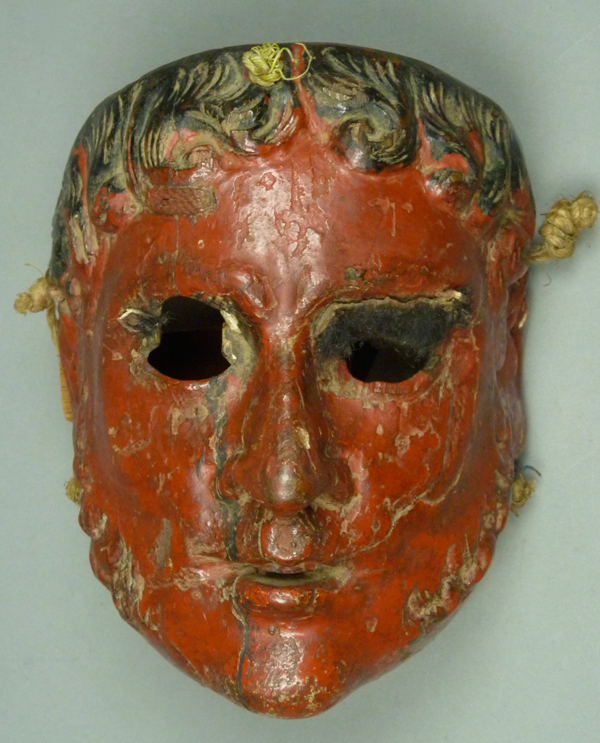

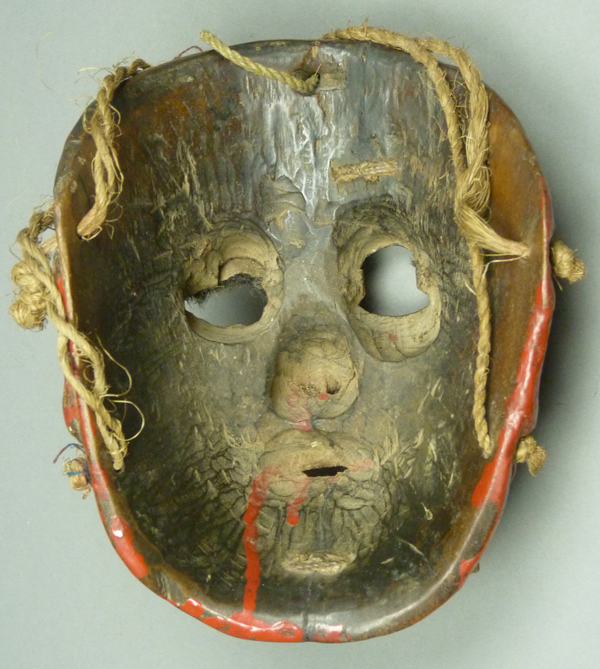

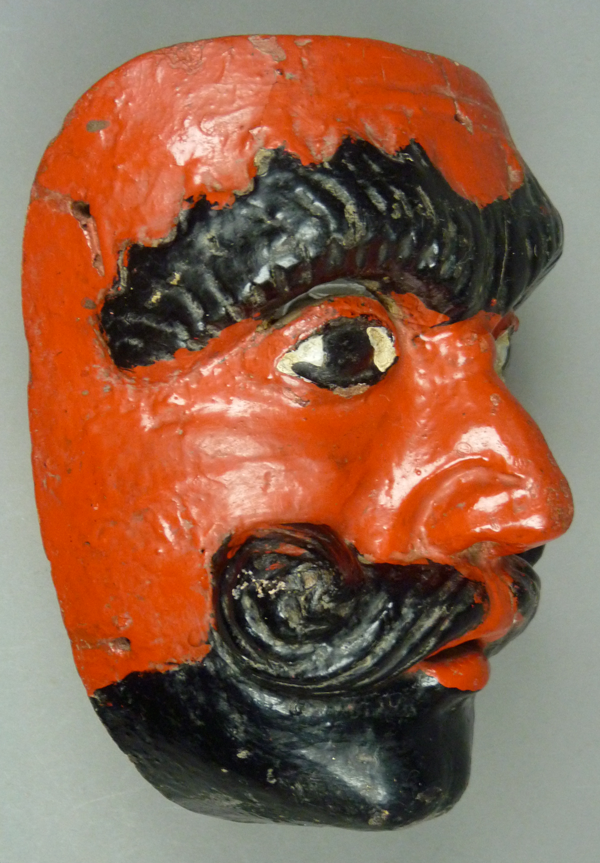
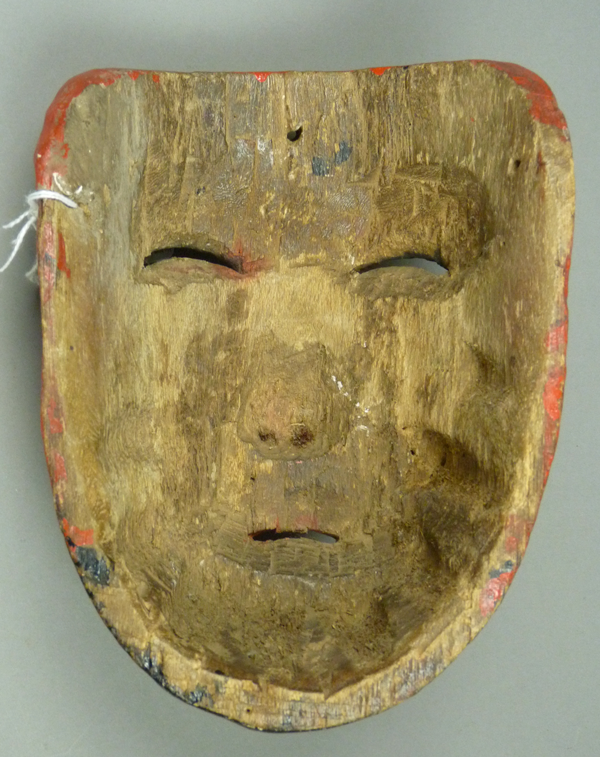










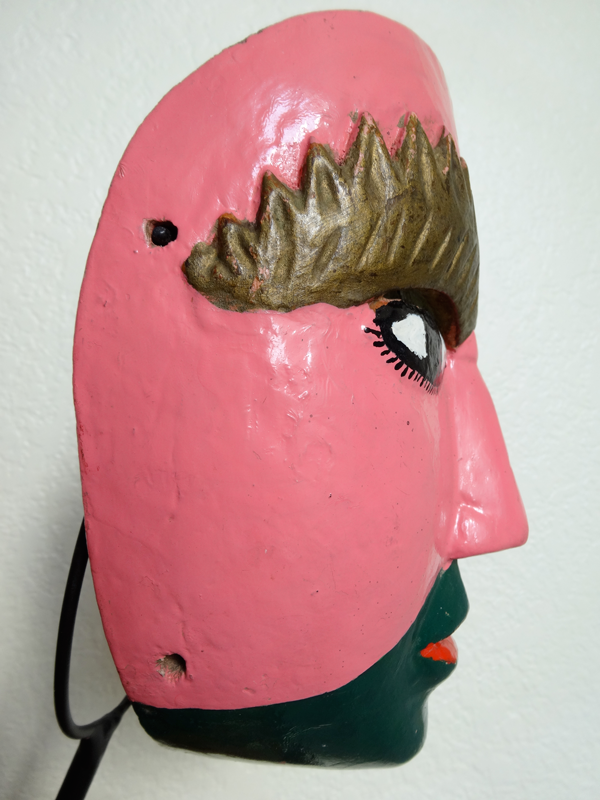

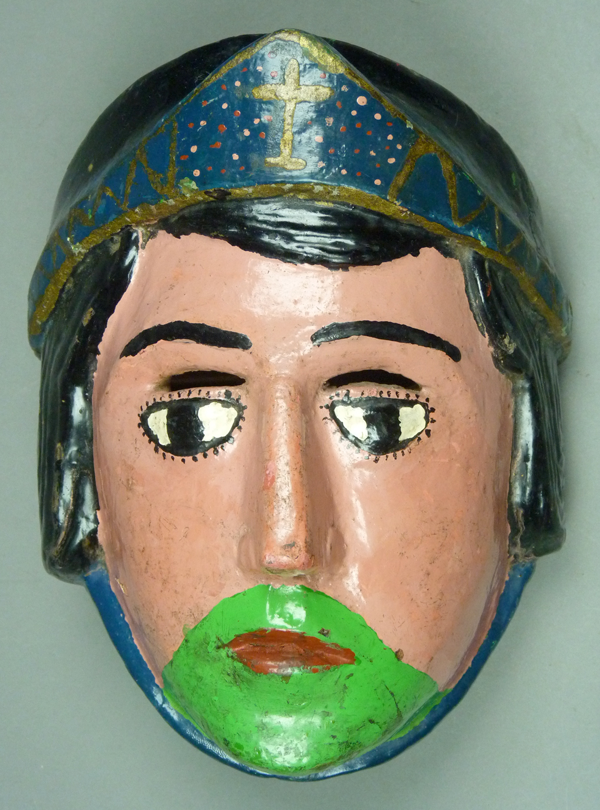
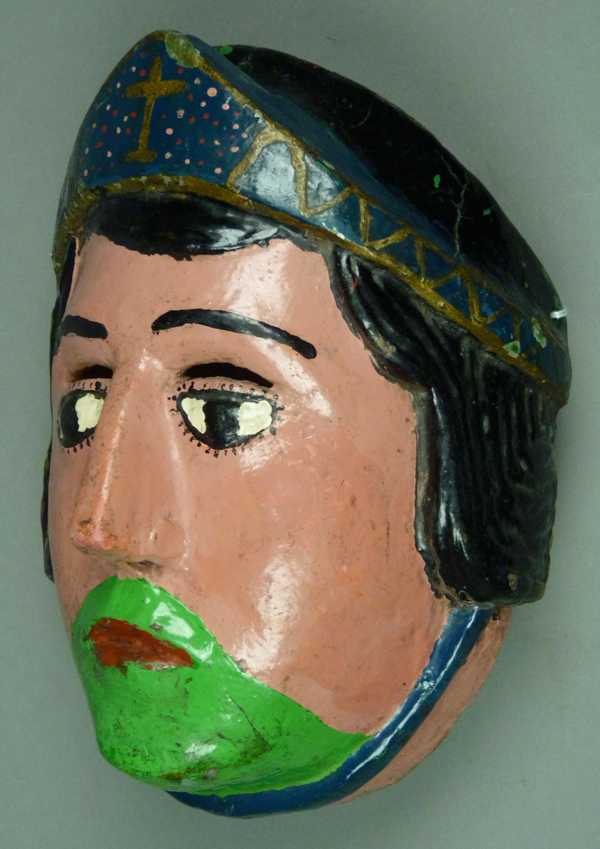
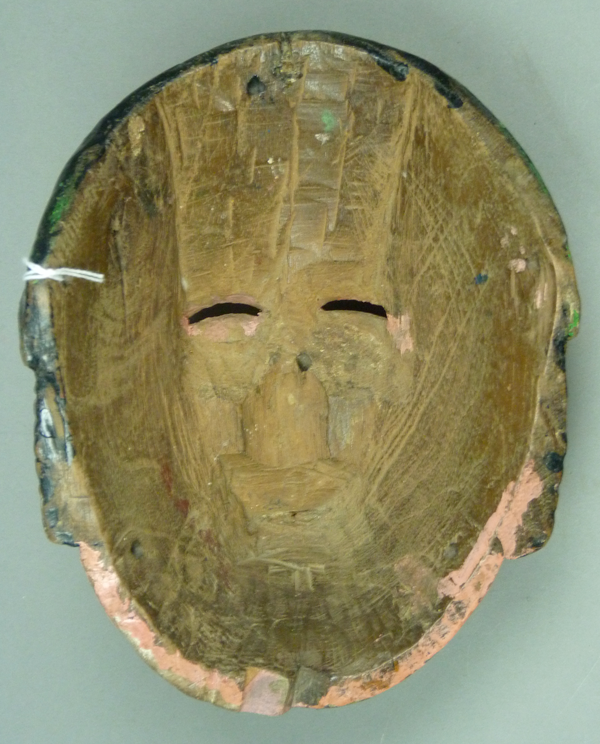
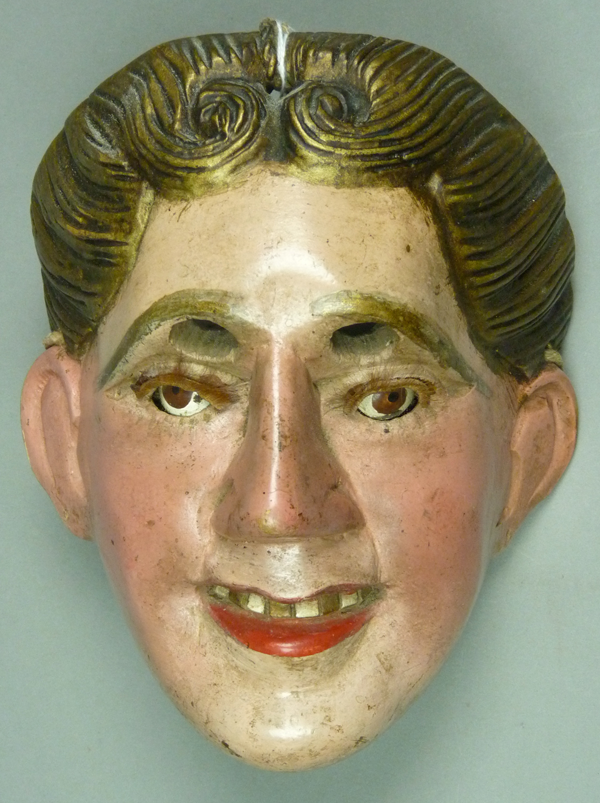
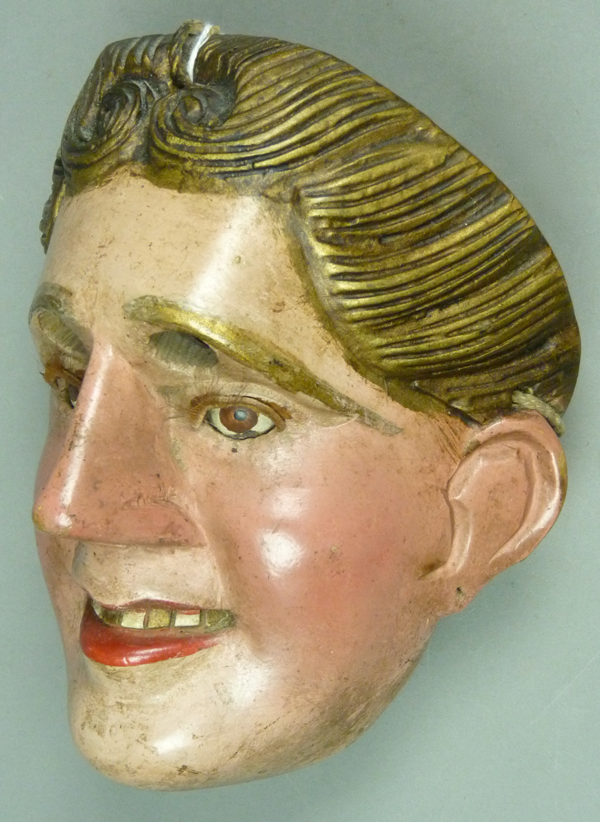
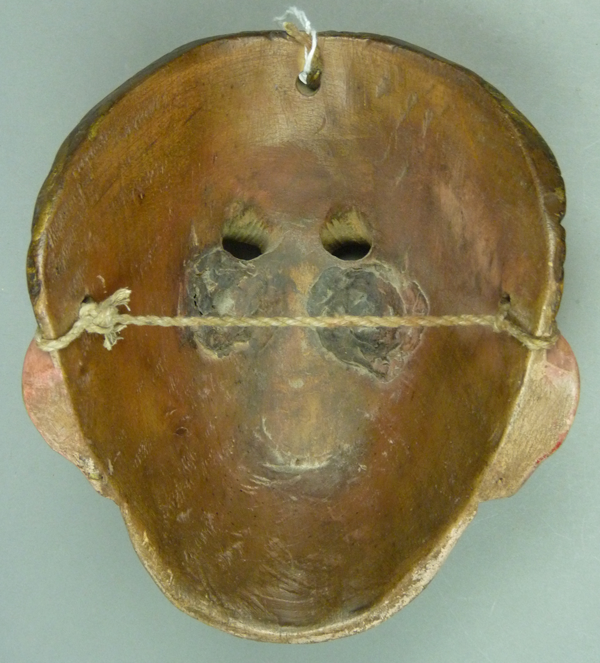
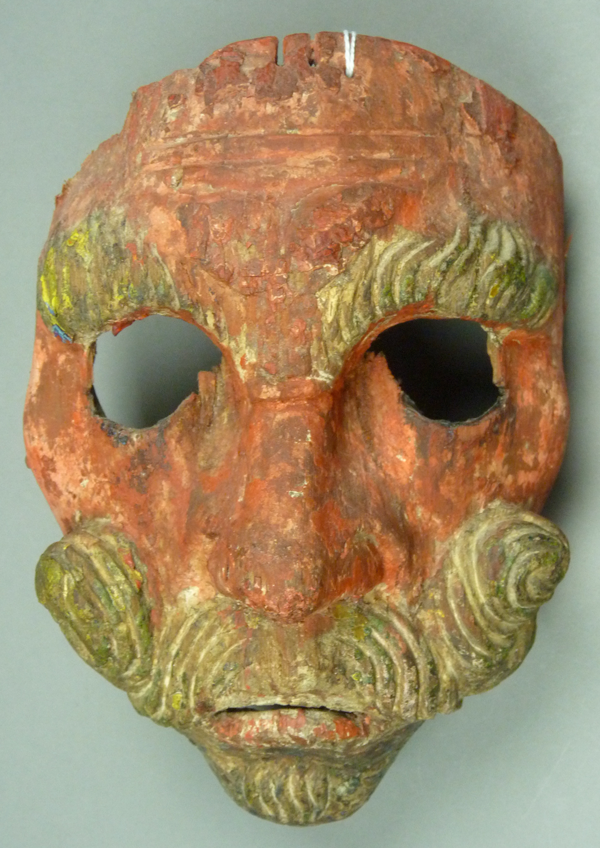
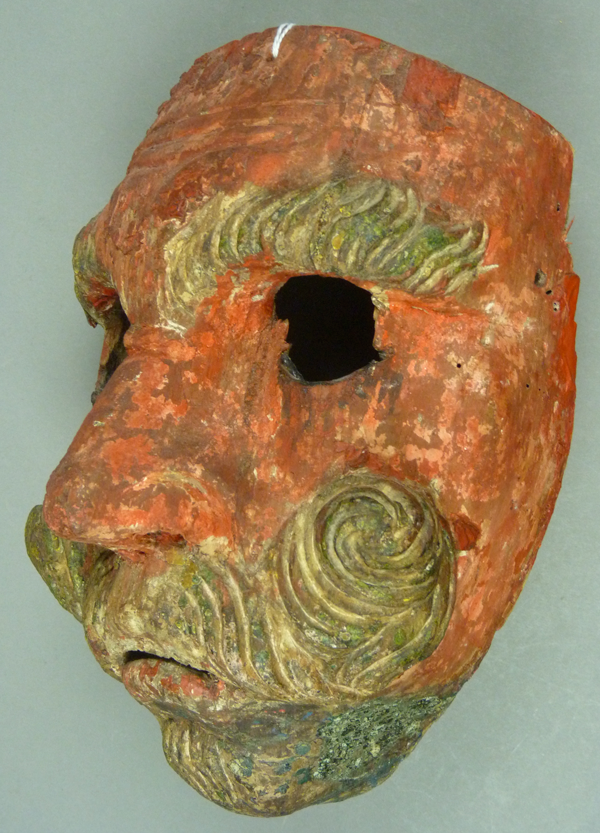
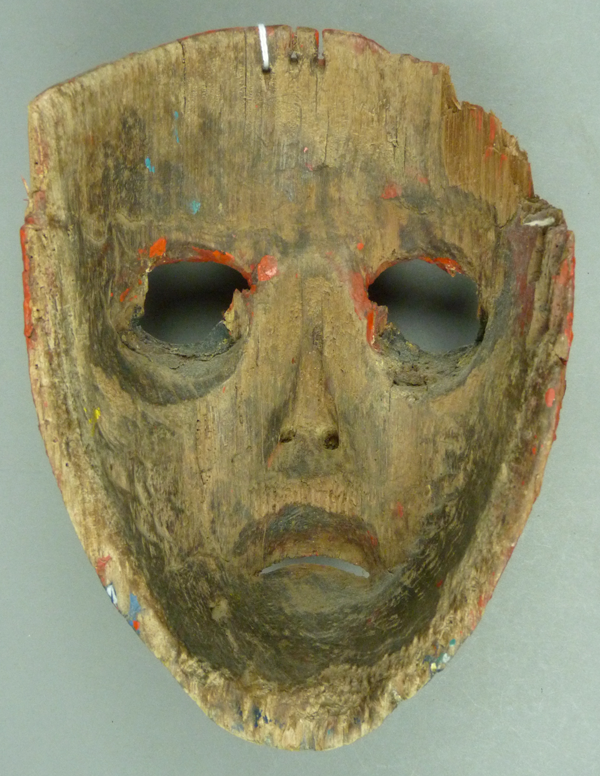
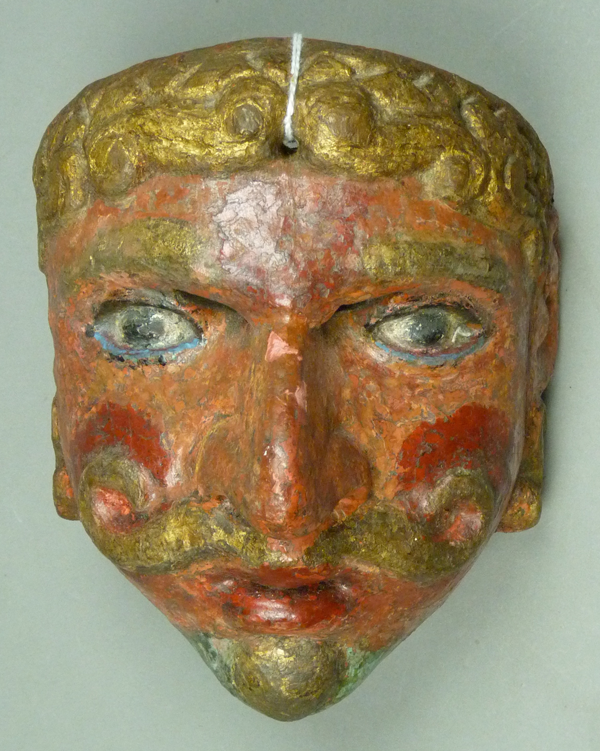
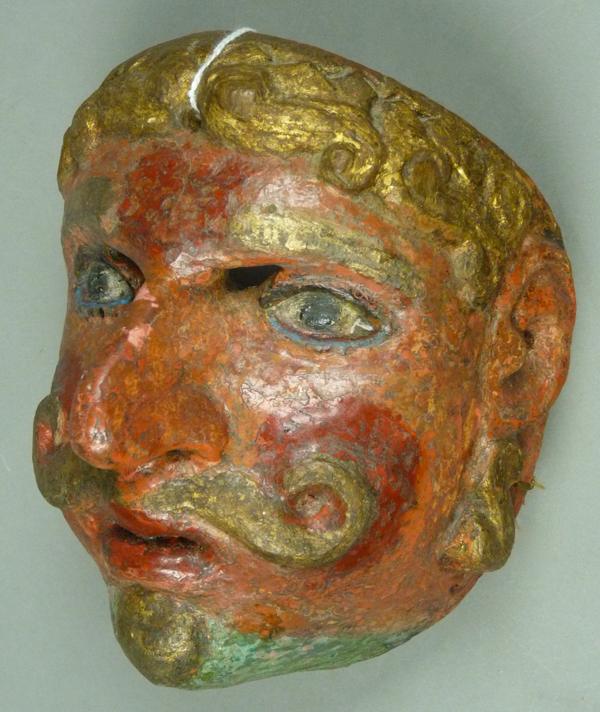

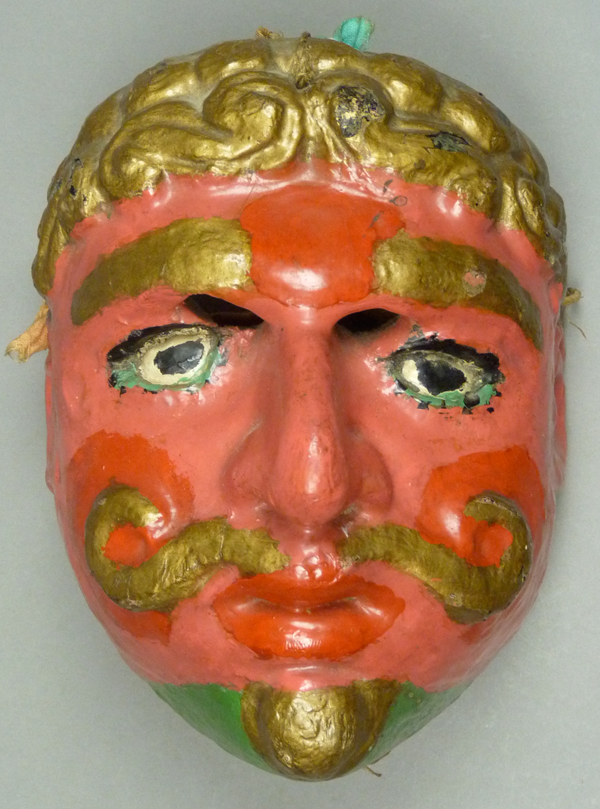
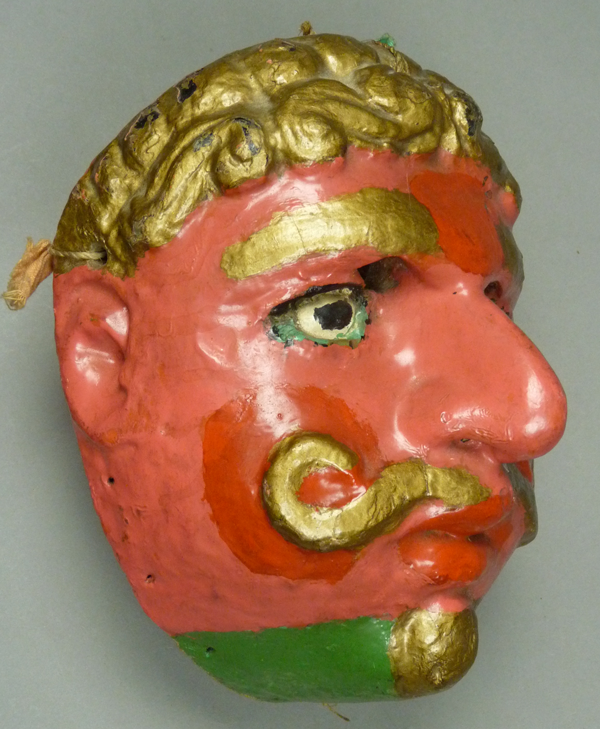
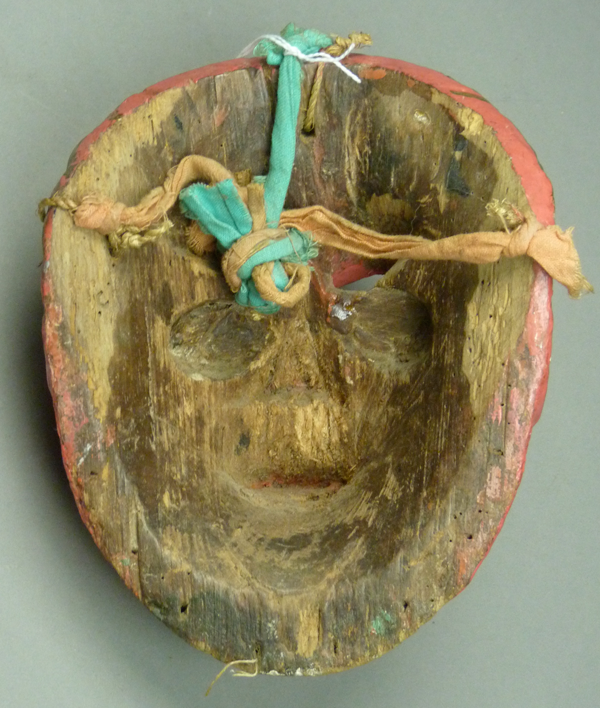
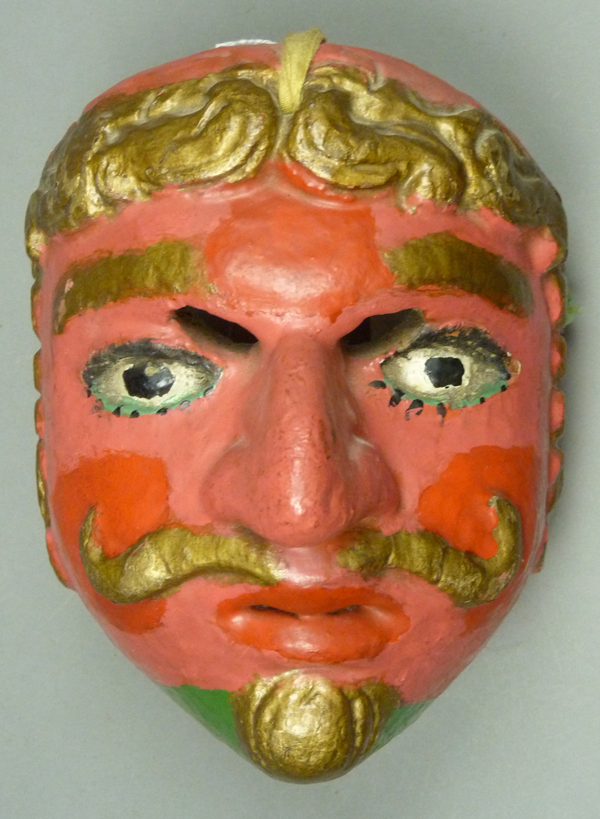
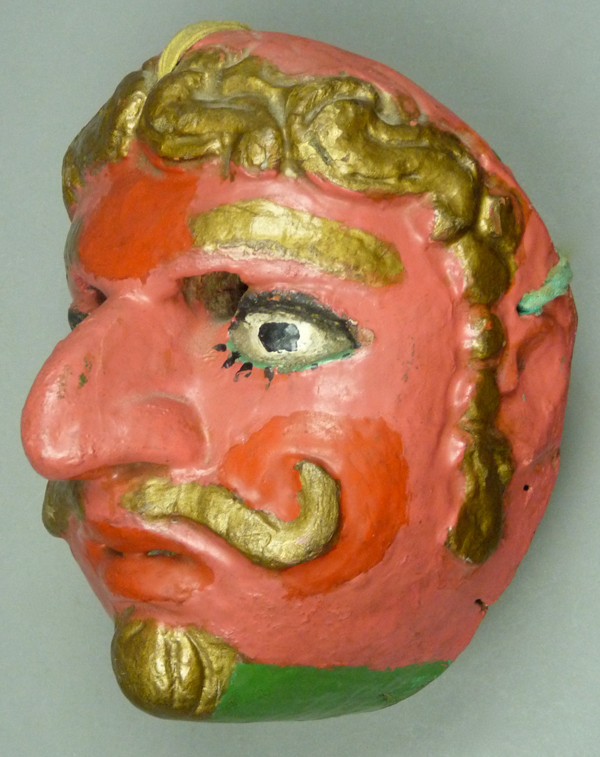
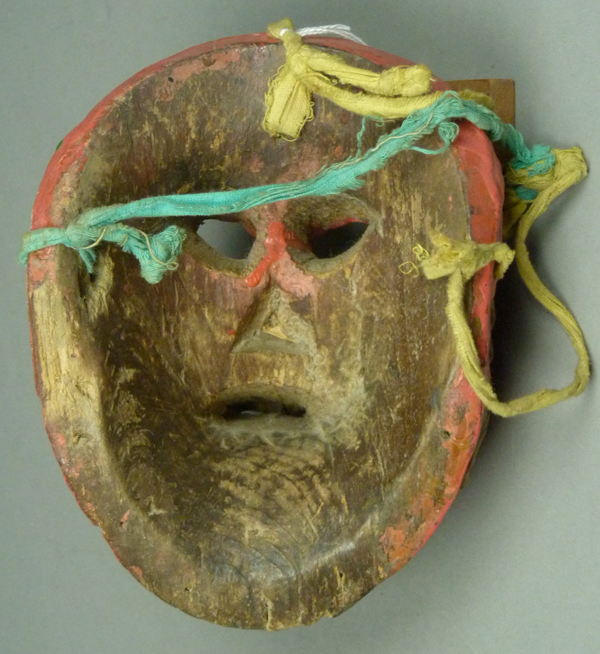
I was so curious to see your page. I bought a mask from an old antique store several years ago and always wondered what it was. It reminded me of old Carnival carvings. Eventually I found the Guatemalan masks and realized that was what it was. The strange thing is mine has the pink face, gold mustache and goatee gold teeth blue glass eyes and the parrots. It’s beautifully carved and the back is very uneven and worn looking. But the thing I find strange is I thought the parrots on the sides were only on the Indian character. Any thoughts? Just curious. My mask is most similar in style and quality to your floripes female mask.
Thanks,
Jenny
HI there! Thanks for your awesome site. So much great information. I would love to ask you a question and show you a photo of a mask I found recently. It looks exactly like the ones that you have here and I am wondering if you could tell me the age and a little about it. I think it’s a Mexican wood dancing mask from the 1930’s
THanks!
Send me photos
Bryan Stevens
Great information on the ritual dance, I also have run across mask linked with a tag. I will send you a picture to hopefully determine its type and value